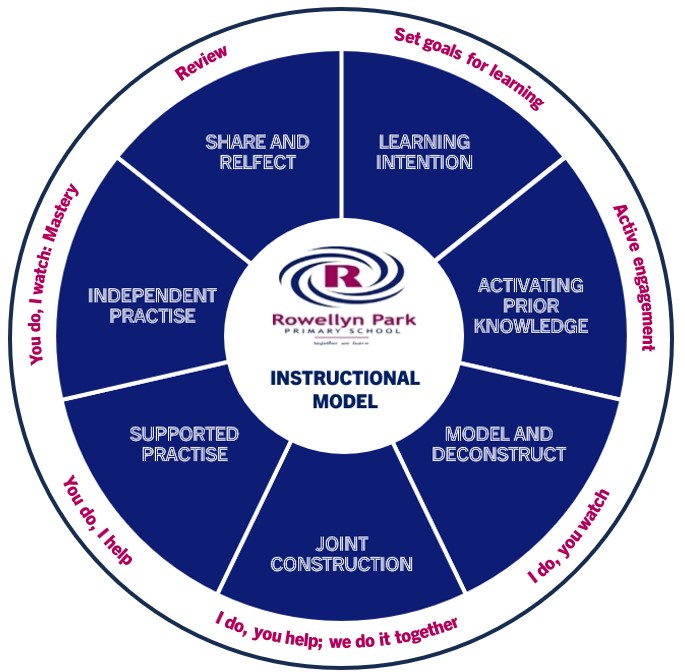
- The gradual release of responsibility model of instruction suggests that cognitive work should shift slowly and intentionally from teacher modelling, to joint responsibility between teachers and students, to independent practise and application by the learner.
- At Rowellyn Park, teachers may choose to begin in any part of the framework. Students move back and forth between each of the components as they master skills, strategies, and standards.
WHAT DOES EACH COMPONENT OF THE MODEL INVOLVE?
| Model Component: | Purpose/Description: |
| Learning Intention Set Goals for Learning | Learning Intentions are descriptions of what learners should know, understand and be able to do by the end of a learning period or unit. Learning intentions are the basis for tracking student progress, providing feedback and assessing achievement. |
| Activating Prior Knowledge Active Engagement | The teacher builds students’ knowledge of the field by explicitly teaching the language associated with the learning. This includes both ‘social’ and ‘academic’ language. The teacher will lead students to revisit required understandings or use this component of the model for spacing and retrieval practise. |
| Model and Deconstruct I do, you watch | The teacher provides and deconstructs models and/or graphic organisers to represent the language, thinking and organisation of strategies. The teacher uses ‘think aloud’ to explicitly model the strategies and language used when deconstructing model. Use worked examples explicit teaching strategies. |
| Joint Construction I do, you help; We do it together | The teacher models the thinking and organisation strategies that are required to demonstrate the knowledge/skill. The teacher or co-educator provides corrective feedback, check for understanding and address misconceptions. Students engage in collaborative learning and peer-based support. |
| Supported Practise You do, I help | The teacher and/or co-educator listens to how students talk about the task, watch how they work and probe into their thinking using prompts. The use of effective questioning supports students to think deeply about their performance and apply the feedback to demonstrate the success criteria. Teachers provide differentiation by enabling or extending student engagement. |
| Independent Practise You do, I watch: Mastery | Students action any feedback independently and build confidence and fluency in relation to the intended learning. |
| Share and Reflect Review | This is where the teacher encourages and facilitates the reviewing and assessing of success in relation to the intended learning. Students engage in metacognition and peer feedback at times. |
VTLM 2.0

The VTLM 2.0 introduces an emphasis on the evidence about how students learn as the basis for effective teaching. It provides increased clarity for teachers about the elements of teaching that have the strongest evidence base. The VTLM 2.0 links to best practice approaches from existing frameworks that contribute to effective student wellbeing and classroom management, such as the Positive Classroom Management Strategies (PCMS).
The VTLM 2.0 provides a streamlined presentation, reducing the previous VTLM’s 5 components to 2 elements:
Elements of Learning – the process of human learning, based on cognitive science, neuroscience and education psychology.
Elements of Teaching – representing the evidence-based teaching practices that most effectively support learning: planning, enabling learning, explicit teaching and supported application.
Guidance is being published in Semester 1 2025 to outline the strategies and practices located within each VTLM 2.0 element of teaching. Links to guides will be inserted in the list below as they become available.
All Victorian government schools are expected to begin implementing the VTLM 2.0 from 2025 and to have it fully embedded in their teaching and learning programs from the start of the 2028 school year.
At Rowellyn Park Primary School, our Instructional Model, evidence based teaching practices and engagement and wellbeing approaches are closely aligned to the Element of Learning and Elements of Teaching outlined in VTLM 2.0.
